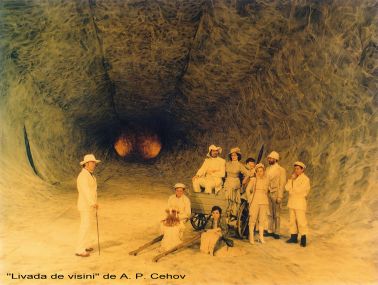The Cherry Orchard | Screening
June 03, 2025
Upstairs Foyer
A play produced in 1985, broadcast by TVR from the National Theater of Târgu-Mureș
Cast: Silvia Ghelan, Luminița Borta, Marinela Popescu, Mihai Gingulescu, Ion Fiscuteanu, Cornel Popescu, Vasile Vasiliu, Livia Doljean, Dan Ciobanu, Monica Ristea, Aurel Ștefănescu, Cornel Răileanu.
Set and costume design: Romulus Feneș
TV production team:
Editing: Emilia Andreescu
Chief cameraman: Ovidiu Druga
TV director: Silviu Jicman
The play premiered 40 years ago at the Târgu-Mureș State Theater and stars two giants of Romanian theater and film: Silvia Ghelan (Ranevskaya) and Ion Fiscuteanu (Lopakhin).
György Harag staged this play at Târgu-Mureș during the last months of his life. In fact, he did not even get to see the premiere and the spectacular set designed by Romulus Feneș, a huge tunnel made of reinforced white cloth, a luminous tunnel in time.
Tompa Gábor, artistic director of the Hungarian Theater of Cluj, considers Harag his mentor and friend. Forty years ago, Harag’s wife called him to ask him to come to Târgu-Mureș and finish staging “The Cherry Orchard,” as Harag was too ill to do so. The production was ready, but the set was not. Due to delays in the construction of the set, which was an extraordinary time tunnel, Romulus Feneș’s set, which Harag had never seen before, was not ready. The stagehands and set designer worked frantically, sewing the huge set directly onto the stage, trying to get the premiere on before the director’s illness overtook him.
Tompa recalls: “I did two things: I placed the performance within the set, as there was nothing I could do to help the actors, and I did the lighting. The performance was extraordinary, even in the empty space. There was a huge 23-meter-deep pit, which was the depth of the stage. At the beginning, Lopakhin came in from the auditorium and felt the curtain, which opened to reveal a second curtain of tulle covering the rest of the stage. You couldn’t tell what was behind it, because you could only see shadows, silhouettes, of Firs, Dunyasha, and the servants waiting. When Ranevskaya and the others arrived from the auditorium, this white curtain rose slowly and took your breath away, as is rarely the case in the theater, revealing an extraordinary space. It was a metaphorical space, simple and concrete, and in a way vegetal, inside this thick white curtain, strips of gauze were stuck together, creating the impression of a blooming garden. They weren’t real flowers—it wasn’t naturalistic. In the background, there were just a few pieces of furniture that seemed almost lost. And behind them, you could see the sun rising—a white curtain lit up by an orange light.”









